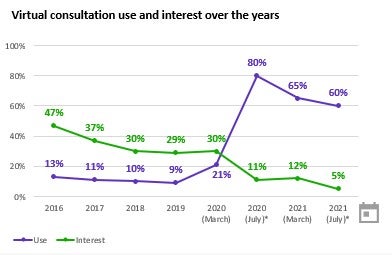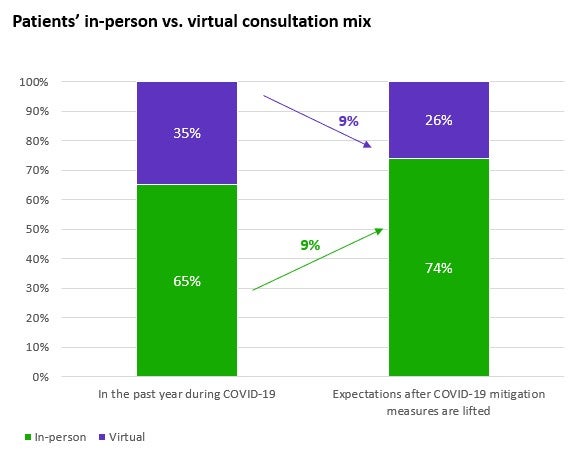As the COVID-19 pandemic continues to evolve, we are seeing substantial shifts in the way patients access healthcare and how providers deliver care. 2021 surveys of patients and physicians in the United States conducted by Clarivate show that:
- Much of care delivery has gone virtual. Three in five physicians in the United States (60%) report having conducted virtual consultations, as do 35% of patients. Physicians indicate that nearly 1 in 4 patient consults (23%) are now performed virtually.

- Patients and physicians alike are seeking more info online. Physicians are relying more on online medical journals, conferences, CME and interactions with peers to inform their practice. The share using physician-only social networks on a monthly basis has increased to 82%, from 58% in 2019, and 37% read pharma email newsletters weekly, versus 30% pre-pandemic (some specialists are more digitally-mature than others – particularly hematology-oncologists, endocrinologists and gastroenterologists).Meanwhile, 37% of patients say they spend a lot more time researching health information because of the pandemic. Patients are most active searching for online health information when preparing for a doctor visit, when 19% do so; after a doctor’s appointment (20%); and after receiving a prescription but before getting it filled (19%).More patients are using both pharma and third-party online info sources. For example, 26% of patients reported visiting pharma condition sites monthly in 2021 – up from 19% a year previous, at the outset of the pandemic. Thirty-nine percent of patients reported visiting general health websites such as WebMD on a monthly basis in 2021 – up from 32% a year before.
Implications for pharma:
The shift toward online information-seeking underscores the importance of investing in sponsored content on trusted third-party websites for both patients and healthcare professionals (HCPs), as well as replenishing owned digital assets with highly-relevant and up-to-date content, whether patient- or HCP-facing. Fully 56% of patients surveyed for the Cybercitizen Health® U.S. 2021 study had researched prescription drug topics online in the past year
- Physician working hours are just getting back to normal after a big spike, likely driven in part by time spent seeing patients remotely. On average, physicians surveyed in the summer of 2021 reported a 13-hour workday, down from an average 16-hour workday in spring, when they were spending 7.9 hours seeing patients. Where telehealth users were spending more time seeing patients in the spring, by summer average time seeing patients was down to 6.7 hours overall, with telehealth users spending slightly less time on patient visits than non-users.
Implications for pharma:
This may indicate that healthcare professionals and practices have summited a telehealth adoption learning curve, and the easing of the time crunch could impact rep access.
- Patients aren’t always getting the support they need – while 56% of patients have received patient support resources from their doctor, some highly valued resources see only modest utilization, including referrals to credible online health resources, patient support programs, condition management tools and health insurance assistance. Thirty-six percent of physicians say they struggle to provide their patients adequate education and support resources when conducting virtual patient consultations.Patients are also struggling with medication adherence – 20% had not filled a prescription in the past 12 months (up from 16% in 2020), and 31% reported being non-compliant with their treatment after getting a prescription filled, up from 26% in 2020.
Implications for pharma:
Pharmas can help to make this transition easier for both patients and physicians by providing patient education and support resources (including adherence tools) in digital formats easily-sharable during or following virtual consults.Companies can utilize the sales channel to disseminate these resources — nearly half of physicians say they prefer to receive patient support (48%) and financial resources (47%) through reps rather than doing their own research.
- The shift to remote consults, conferences and meetings will likely be an enduring one, though it may soften somewhat as COVID-19 rates come under control. While 53% of patients expect to make more in-person doctor visits as the COVID-19 crisis abates, 40% say they plan to use virtual consults for most follow-ups. Physicians expect to attend slightly more conferences virtually than in-person post-pandemic, and anticipate seeing reps virtually much more frequently than they did pre-COVID-19.
 Among U.S. physicians; Source: Clarivate, Cybercitizen Health(R) U.S. 2021
Among U.S. physicians; Source: Clarivate, Cybercitizen Health(R) U.S. 2021Implications for pharma:
While in-person rep interactions are now coming back, it’s not at the expense of remote rep touchpoints, for which monthly reach has doubled in the past year. Pharmas can utilize live video calls and webcasts to render a personalized and impactful interaction.
Virtual conferences are an important source of clinical information in this emerging hybrid online-offline world. Companies can enhance the virtual conference experience with in-demand features like resource centers, access to experts, and KOL sessions.
Methodology: All data cited are from Clarivate patient and physician studies, including Cybercitizen Health U.S. 2021, fielded in April and May, 2021, Taking the Pulse U.S. 2021 (March-May 2021), and Re-Taking the Pulse: COVID Toolkit U.S. 2021 (July-August 2021).
To learn more about Clarivate studies of patient, physician and payer multichannel behavior, or to talk to a multichannel expert, visit our Multichannel Insights page: https://clarivate.com/products/biopharma/customer-engagement/multichannel-insights/






